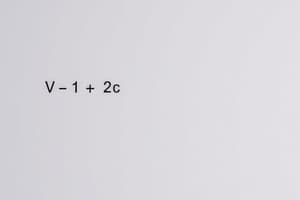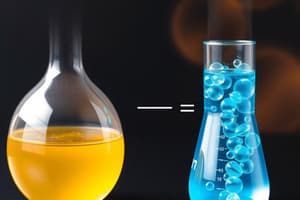Podcast
Questions and Answers
What is an isotherm in the context of real gases?
What is an isotherm in the context of real gases?
- A curve showing the relationship between pressure and volume at constant temperature (correct)
- A graph depicting kinetic energy changes in gases over time
- A diagram representing molecular interactions in gases
- A line indicating temperature changes at constant pressure
How do Van der Waals isotherms differ from those of ideal gases?
How do Van der Waals isotherms differ from those of ideal gases?
- They account for intermolecular forces and molecular volumes. (correct)
- They only apply at very high pressures.
- They are linear rather than curvilinear.
- They assume infinite volume for gases under all conditions.
What characteristic feature can be observed in the isotherms of real gases?
What characteristic feature can be observed in the isotherms of real gases?
- A constant slope across all temperatures.
- A loop or hysteresis in the pressure-volume graph. (correct)
- An intersection with the ideal gas isotherm line.
- A sharp change in volume at constant pressure.
At what conditions do the isotherms of real gases best approximate the ideal gas laws?
At what conditions do the isotherms of real gases best approximate the ideal gas laws?
What modification does the Van der Waals equation introduce to the ideal gas law?
What modification does the Van der Waals equation introduce to the ideal gas law?
Flashcards are hidden until you start studying
Study Notes
Isotherms in Real Gases
- Isotherms are graphical representations of the pressure (P) of a gas as a function of its volume (V) at a constant temperature (T).
Van der Waals Isotherms vs Ideal Gas Isotherms
-
Unlike the ideal gas isotherms, which are perfect hyperbolas described by Boyle's law (PV = constant), Van der Waals isotherms exhibit more complex behavior.
-
The Van der Waals isotherms deviate from the ideal gas law due to the inclusion of intermolecular forces and finite molecular volume.
Characteristic Feature: Van der Waals Loops
-
A distinctive characteristic of Van der Waals isotherms is the presence of "loops" at lower temperatures. These loops indicate that the gas can exist in multiple states (liquid, vapor, or a mixture) at a given pressure and temperature.
-
These loops are not physically realistic and represent an artifact of the Van der Waals equation.
Approximating Ideal Gas Laws
-
The Van der Waals isotherms approximate the ideal gas laws more closely at high temperatures and low pressures.
-
Under these conditions, the intermolecular forces and molecular volumes become less significant compared to the average kinetic energy of the gas molecules.
Van der Waals Equation Modification
-
The Van der Waals equation modifies the ideal gas law by introducing two correction terms:
a/V^2: accounts for the attractive intermolecular forces between gas molecules.b: accounts for the finite volume occupied by the gas molecules.
-
The Van der Waals equation is: (P + a/V^2)(V - b) = RT
Studying That Suits You
Use AI to generate personalized quizzes and flashcards to suit your learning preferences.



